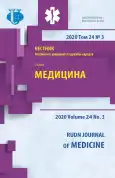Physiological and clinical aspects in COVID-19
- Authors: Satyanath R.K.1, Sorout J.1, Jayachandra S.2, Gandhi A.3, Kacker S.4
-
Affiliations:
- Kanti Devi Medical College, Hospital and Research Centre
- Zydus Medical College and Hospital
- Faculty of Medicine and Health Science. S.G.T University
- RUHS College Of Medical Science
- Issue: Vol 24, No 3 (2020)
- Pages: 201-206
- Section: IMMUNOLOGY
- URL: https://journal-vniispk.ru/2313-0245/article/view/319596
- DOI: https://doi.org/10.22363/2313-0245-2020-24-3-201-206
- ID: 319596
Cite item
Full Text
Abstract
About the authors
R. Kodidala Satyanath
Kanti Devi Medical College, Hospital and Research Centre
Email: ksatyanath1989@gmail
Mathura, India
J. Sorout
Kanti Devi Medical College, Hospital and Research Centre
Email: ksatyanath1989@gmail
Mathura, India
S. Jayachandra
Zydus Medical College and Hospital
Email: ksatyanath1989@gmail
Gujarat, India
A. Gandhi
Faculty of Medicine and Health Science. S.G.T University
Email: ksatyanath1989@gmail
Budhera, Gurgram, India
S. Kacker
RUHS College Of Medical Science
Email: ksatyanath1989@gmail
Jaipur, India
References
- Zhou P., Yang X.L., Wang X.G., Hu B., Zhang L., Zhang W., et al. Discovery of a novel coronavirus associated with the recent pneumonia outbreak in humans and its potential bat origin. BioRxiv. 2020.
- Coronavirus Outbreak. Available at: https://www.worldometers. info/ coronavirus Accessed 14, April 2020.
- https://www.worldometers.info/coronavirus/#countries. Accessed 14, April 2020.
- Chan J.F., To K.K., Tse H., Jin D.Y., Yuen K.Y. Interspecies transmission and emergence of novel viruses: lessons from bats and birds. Trends Microbiol. 2013 Oct; 21(10):544-55.
- Chen Y., Liu Q., Guo D. Emerging coronaviruses: Genome structure, replication, and pathogenesis. J. Med. Virol. 2020 Apr;92(4):418-423.
- World Health Organization. Situation reports. Available at: https:// www.who.int/emergencies/diseases/novel-coronavirus-2019/ situation-reports/. Accessed 22 Feb 2020.
- Sagar Kulkarni (3 April 2020). «India would have seen 31,000 coronavirus cases without lockdown: Researches». Deccan Herald. Retrieved 4 April 2020.
- Wan Y., Shang J., Graham R., Baric R.S., Li F. Receptor recognition by novel coronavirus from Wuhan: an analysis based on decade-long structural studies of SARS. J Virol. 2020. https:// doi.org/10.1128/JVI.00127-20
- Tortorici M.A., Veesler D. Structural insights into coronavirus entry. Adv Virus Res. 2019;105:93-116.
- Perrier A., Bonnin A., Desmarets L., Danneels A., Goffard A., Rouille Y., et al. The C-terminal domain of the MERS coronavirus M protein contains a trans- Golgi network localization signal. J Biol Chem. 2019; 294(39):14406-21.
- Ben Addi A., Lefort A., Hua X., Libert F., Communi D., Ledent C., et al. Modulation of murine dendritic cell function by adenine nucleotides and adenosine: involvement of the A(2B) receptor. European journal of immunology. 2008; 38: 1610-20.
- Mathern D.R., Heeger P.S. Molecules Great and Small: The Complement System. Clin J Am Soc Nephrol. 2015; 10: 1636-50.
- Traggiai E., Becker S., Subbarao K., Kolesnikova L., Uematsu Y., Gismondo M.R., et al. An efficient method to make human monoclonal antibodies from memory B cells: potent neutralization of SARS coronavirus. Nat Med. 2004; 10:871-5.
- Center for Disease Control and Prevention [Internet]. Atlanta: CDC; c2020 [cited 2020 April, 14]. Symptoms of Novel Coronavirus (2019-nCoV); [about 1 screen]. Available from: https://www.cdc. gov/coronavirus/2019-ncov/ about/symptoms.html.
- Huang C., Wang Y., Li X., Ren L., Zhao J., Hu Y., et al. Clinical features of patients infected with 2019 novel corona virus in Wuhan, China. Lancet. 2020; 395:497-506.
- Siddiqi H.K., Mehra M.R. COVID-19 illness in native and immune suppressed states: a clinical-therapeutic staging proposal. J. Heart Lung Transplant. 2020. 39(5): 405-407.
- Chen C., Zhang X.R., Ju Z.Y., He W.F. Advances in the research of cytokine storm mechanism induced by Corona virus disease 2019 and the corresponding immunotherapies. Chin. J. Burns. 2020 Mar 01; 36(0): E005.
- Huang C., Wang Y., Li X., Ren L., Zhao J., Hu Y. Clinical features of patients infected with 2019 novel coronavirus in Wuhan, China. Lancet. 2020; 395:497-506.
- Sun P., Lu X., Xu C., Sun W., Pan B. Understanding of COVID-19 based on current evidence. J. Med. Virol. 2020 Mar 5: 10.1002/ jmv.25722.
- Chan K.W., Wong V.T., Tang S.C.W. COVID-19: an update on the epidemiological, clinical, preventive and therapeutic evidence and guidelines of integrative Chinese-Western medicine for the management of 2019 novel coronavirus disease. Am.J. Chin. Med. 2020:1-26.
- Conti P., Ronconi G, Caraffa A, Gallenga C.E, Ross R, Frydas I. Induction of pro-inflammatory cytokines (IL-1 and IL-6) and lung inflammation by Coronavirus-19 (COVI-19 or SARSCoV-2): anti-inflammatory strategies. J. Biol. Regul. Homeost. Agents. 2020 Mar 14;34(2):1. doi: 10.23812/CONTI-E.
- Zhou F., Yu T., Du R., Fan G., Liu Y., Liu Z. Clinical course and risk factors for mortality of adult in patients with COVID-19 in Wuhan, China: a retrospective cohort study. Lancet. 2020 Mar 28;395(10229):1054-1062. doi: 10.1016/S0140- 6736(20)30566-3.
- Ruan Q., Yang K., Wang W., Jiang L., Song J. Clinical predictors of mortality due to COVID-19 based on an analysis of data of patients from Wuhan, China. Intensive Care Med. 2020; 46:846-848
- Chen N., Zhou M., Dong X., Qu J., Gong F., Han Y. Epidemiological and clinical characteristics of 99 cases of 2019 novel ological and clinical characteristics of 99 cases of 2019 novel coronavirus pneumonia in Wuhan, China: a descriptive study
- Chen N., Zhou M., Dong X., Qu J., Gong F., Han Y. Epidemi-coronavirus pneumonia in Wuhan, China: a descriptive study. Lancet. 2020;395:507-513. Lancet. 2020;395:507-513.
Supplementary files









